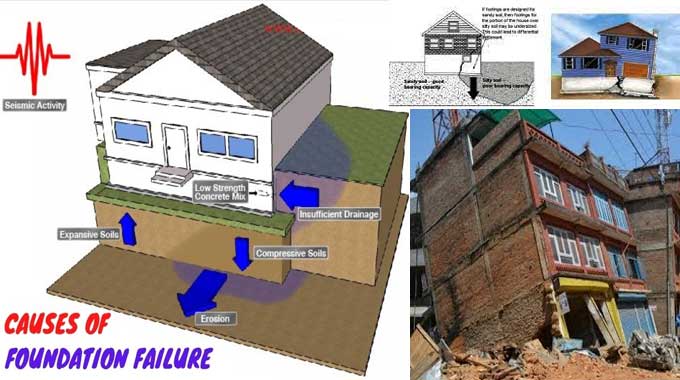
Here are 7 Causes of Foundation Failure and how to fix them Efficiently
Structures such as foundation support loads acting on a superstructure. There is a connection between the structure and its eventual support, the soil below. Loads are transferred either directly on soil or rock or indirectly through intermediate elements such as piles or caissons.
The foundation is crucial to the structural stability of the house. You may end up spending a lot of money to fix a foundation issue if you ignore a minor issue. Prevention would be worth a pound of cure as long as it somehow relates to foundations. Several factors influence the development of this issue. An accurate diagnosis and repair of a problem might be hard.
Reasons for Foundation Failure
When a foundation's subsoil shrinks & dries out
When the weather is hot and dry, the soil below the foundation shrinks. It causes the foundation's support to break away from the soil, making it unstable and susceptible to shifting. Cracks may appear in the ceiling, walls, and floors and you may find it difficult to open windows and doors once the foundation shifts.
Excessive Water Absorption
Too much moisture beneath the foundation can cause foundation problems. Too much water causes the soil to swell and enlarge. A result of this is that floors, walls, and ceilings become cracked, among other things. The floors may start to slant as a result of the extreme upward movement.
Designing Error
The design of many foundations is poor because there is insufficient precedent investigation of the subsurface. An inadequate subsurface investigation may result in inadequate support of the superstructure. Such structures often end up requiring costly corrective measures in the future.
The goal of reducing initial construction costs often leads to a design error. A false economy in the construction process is, for instance, placing floor slabs on inadequate soil fills. To measure true cost efficiency, you must take into account both the initial and life-cycle costs.
Construction Error
During construction, temporary protection measures are a common source of construction errors, and foundation work is a common source of foundation errors.
First, most foundation failures are the result of shoring and bracing errors, as well as temporary cofferdams for lateral protection and pumping operations. Temporary structures usually have minimal safety measures due to their temporary nature.
Additionally, the concrete quality is poor, and the position of the reinforcing bar in the foundation. Quality control is often lacking in cast-in-place piles. Most of the huge losses caused by such errors come from omitting verification methods early on in the construction process.
Soil Erosion
Soil erosion can be caused by inadequate drainage around the house. As a result, the foundation of the home might become unstable. Walls can buckle & structures to begin to tilt, etc. It is also possible for soil erosion to lead to a large void underground.
Unequal Support
Deformation is a basic principle of foundation mechanics. Deformation of the soil occurs when loads transfer to the soil through the foundation. Thus, the foundation settles as it loads. The amount of settlement for different footings will be equal if soil resistance and load distribution are equal.
In contrast, differential settlements occur when the coil resistances are not identical. The part of the structure founded on weaker soil may tip over. The brittle masonry enclosure will crack when the framework is not continuous.
Naturally Formed Sinkholes
Whenever water flushes underground, sinkholes form. There is no external drainage outlet. The result is soil erosion underground that may result in underground tunnels.
Repairing Solution
Slab Jacking Technique
Slab jacking is the process of pumping cement grout into small, strategically positioned holes in a concrete slab. In slab jacking, grout is pumped beneath the pavement or beam to create a lifting pressure that allows it to rise back to its original height. Installed grout provides a firm impact on the concrete slab once it reinforces into a dense concrete structure.
If sediment grout is not for use, sludge may retain the benefits of lime stabilization at both its base and sub-base. Through this intervention, not only is the slab restored to its proper grade, but the subsoil also settles to prevent future problems.
Pilings & Piers Technique
Lovely plantation-style home has long and cylindrical pilings, such as columns, along with its front balcony. Think of a house that supports on stilts below ground, but they are underground. As with bell-bottom piers, the supports weren't assembled above ground but drive underground while the concrete poured.
Raising the House
After the foundation repair service provider attempts to install the supports in the underground, he will raise the submerged portions of the house and check if its foundation has already returned to its average elevation.
A pressed pile process raises the house by applying pressure to the piles underground. If you insert a battery into a device, a spring holds it in position. Spring represents the ground, while battery represents the pressed pile.
Ensure the right elevation of the house, either a jack or shims would use. Through the use of bell-bottom piers, a support pier establishes the foundation to raise the house.
In addition, hydraulic jacks were installed on the highest part of the pier, allowing the house to lift using jacks. Shims will hammer in place to maintain the home's elevated view.
Conclusion
Identifying the cause of the distress is the best way to determine the remedy. In low-level windows, trim boards, moldings, and mortar joints, you might find hints.
To get more details, watch the following video tutorial.
Video Source: The NorthCap University Gurugram
It is possible for the soil to move if it is unusually wet or dry. Keep an eye on the weather as well. Make your final decision based on more than the price. You should be wary of anything that appears too good to be true.


